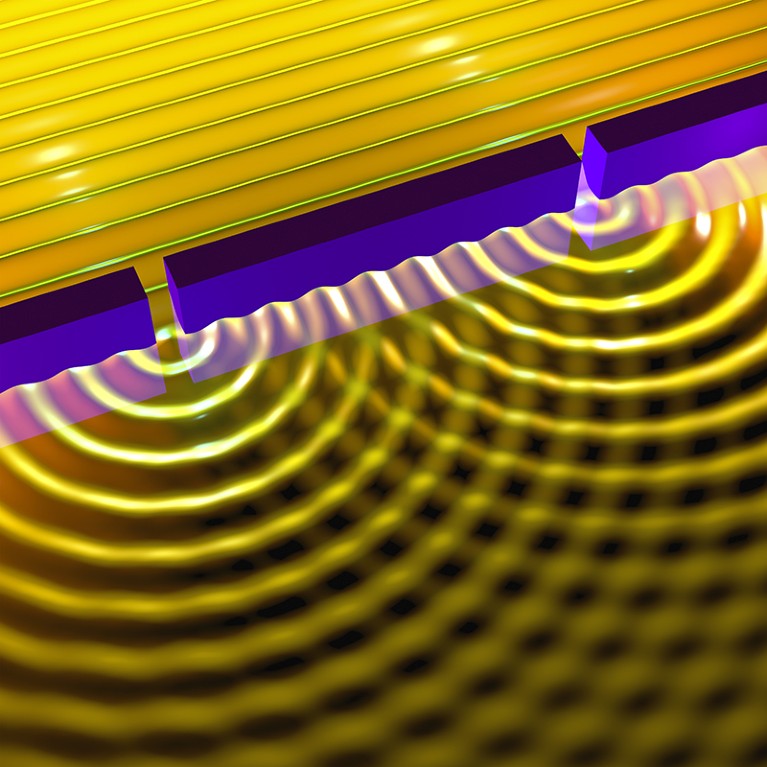

The classic double-slit experiment leads to characteristic interference patterns.Credit: Russell Knightly/SPL
A celebrated experiment in 1801 showed that light passing through two thin slits interferes with itself, forming a characteristic striped pattern on the wall behind. Now, physicists have shown that a similar effect can arise with two slits in time rather than space: a single mirror that rapidly turns on and off causes interference in a laser pulse, making it change colour.
The result is reported on 3 April in Nature Physics1. It adds a new twist to the classic double-slit experiment performed by physicist Thomas Young, which demonstrated the wavelike aspect of light, but also — in its many later reincarnations — that quantum objects ranging from photons to molecules have a dual nature of both particle and wave.
The rapid switching of the mirror — possibly taking just 1 femtosecond (one-quadrillionth of a second) — shows that certain materials can change their optical properties much faster than previously thought possible, says Andrea Alù, a physicist at the City University of New York. This could open new paths for building devices that handle information using light rather than electronic impulses.
Romain Tirole, a quantum physicist at Imperial College London, and his collaborators shot an infrared laser at a surface made of layers of gold and glass with a thin coating of indium tin oxide (ITO), a material common in smartphone screens.
Under normal conditions, ITO is transparent to infrared light. But the researchers were able to make the material reflective using a second laser, which excited electrons in the material, affecting its optical properties. This could be done with pulses from the second laser that lasted foraround 200 femtoseconds.
The team positioned a light sensor along the reflected beam. When they shot two ultrashort pulses separated by a few tens of femtoseconds — therefore turning the ITO mirror on twice in rapid succession — they saw that the waveform of the twice-reflected light changed in response. It went from a simple, monochromatic wave to a more complex one.
The results also showed that the ITO took less than 10 femtoseconds to get excited — much faster than expected theoretically or from previous measurements. “The reason why everybody else thought it would be slower is that they used a different technique to measure the response time, which was limited to 50–100 fs,” says co-author Riccardo Sapienza, a physicist at Imperial College.
The interference disappears if the mirror is turned on only once2. This is analogous to what happened in the classic Young experiment, where the interference patterns vanished if the light was shone through one slit rather than two.
The most exciting outcome, according to Alù, is that the researchers have shown that it is “possible to change the properties of ITOs very quickly”. Such rapid switching could lead to devices that reflect signals in time — the optical analogue of playing a musical record backwards.
In general, achieving such a feat with any kind of wave requires generating an abrupt and pronounced change in a medium’s properties across a sufficiently large volume. Until this year, a similar result had been achieved only with water waves3. But last month, in Nature Physics4, Alù and his collaborators demonstrated it for the first time with electromagnetic waves, by propagating microwave signals through electronic circuits. So far, the Imperial College ITO has shown a large and abrupt change, but over only a thin surface — the biggest challenge will be to extend such a result over a larger volume.
Meanwhile, Tirole and Sapienza are working with collaborators to reproduce the two-mirror effect with sound waves, such as those propagating on a membrane. “All the physics we study is about waves, so we can easily apply the same concepts to different domains,” says Sapienza. “This can bring about more applications, for example novel antennas for 6G, using time to combine many antennas in one.”
Temporal interference and time reversal could lead to new ways of creating time crystals, which are mind-bending structures that repeat periodically, not in space — as ordinary crystals do — but in time. They could also help researchers build quantum computers based on photons.

